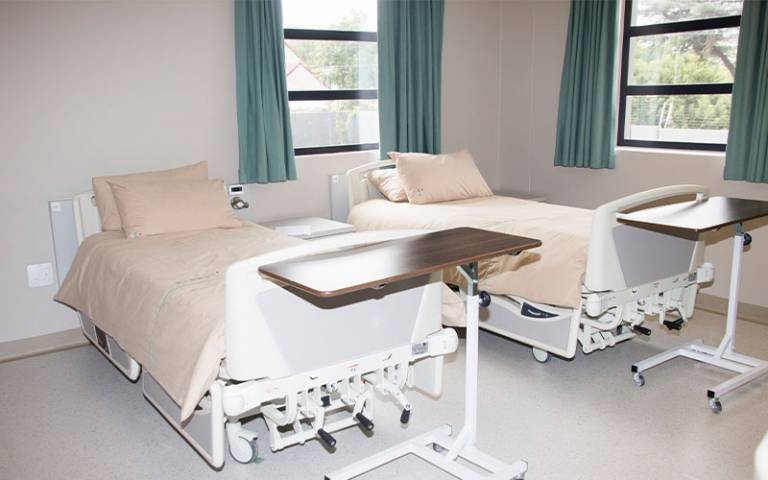Daylight in hospitals: health and wellbeing impacts on patients
11 March 2021
Environmental Design and Engineering MSc student Haoyue Li reviews the healing potential of daylight in healthcare facilities.

This blog post was produced as part of the Health, Comfort and Wellbeing in the Built Environment Module*
It is well known that sick building syndrome has a negative impact on health and work efficiency of workers in offices [1]. This problem not only exists in offices, but also occurs in other buildings like healthcare facilities. The physical environment can affect the health and wellbeing of patients and staff in healthcare facilities [2–4]. Hospital patients are likely to be more sensitive than the general population to physical environment disturbances, such as harsh lights or noise. Hence, it is important for designers and architects to consider what environmental factors can influence the health of patients and how to deal with those issues.
Previous studies have identified a variety of building-related factors that can affect the health and wellbeing of patients, including: ventilation, acoustic environment, thermal environment, lighting and daylight, spatial layout and room type, view and access to nature. Daylight can not only improve patients’ visual comfort, but also bring potential benefits to their physical health [5]. However, the benefit of daylight is perhaps underappreciated because it is difficult to quantify its effects.
Daylight affects our physical and psychological conditions by influencing chemical reactions and hormone secretion in the body [6]. The study carried out by Bjorvatn et al.[7] found that exposing patients to daylight helped regulate secretion of cortisol and melatonin, which are associated with circadian rhythm. Walch et al.[8] found that increased exposure to sunlight after spinal surgery reduced perceived stress, pain and use of pain medication. In addition a study by Choi et al. [9] conducted at a general hospital in Korea found that the length of stay for patients who have better source of daylight was 16%-41% shorter than other patients.
Exposure to daylight can benefit the synthesis of vitamin D, thus reducing bone related diseases [10], and it also play an important role in preventing infectious diseases by modifying pathogen fitness [11]. Furthermore, daylight can also help to improve seasonal affective disorder and reduce depression [12]. However, excess sunlight exposure can cause immune suppression, skin cancer, sunburn and other adverse impacts from ultraviolet radiation [5,13]. Moreover, excess sunlight due to poor design can cause glare and overheating which will affect people’s physical and mental health [9].
In conclusion, rational use of daylight can support the health and wellbeing of patients. The recommended daylight factor is 2-5% in patients’ spaces in healthcare facilities, and most areas should achieve 3%, and uniformity level of daylight should between 30-50% [14,15]. An effective shading strategy is needed to prevent excessive daylight intake. Daylighting design in healthcare facilities is still developing and further research is needed regarding the use of daylight to reduce infectious disease transmission.
*The Health, Comfort and Wellbeing in the Built Environment Module is led by Dr Helen Pineo and it is core component of the Environmental Design and Engineering MSc and the Health, Wellbeing and Sustainable Buildings MSc programmes.
References
- Burge PS. Sick building syndrome. Vol. 61, Occupational and Environmental Medicine. 2004. p. 185–90.
- Salonen H, Lahtinen M, Lappalainen S, Nevala N, Knibbs LD, Morawska L, et al. Physical characteristics of the indoor environment that affect health and wellbeing in healthcare facilities: a review. Intell Build Int. 2013;5(1):3–25.
- Huisman ERCM, Morales E, van Hoof J, Kort HSM. Healing environment: A review of the impact of physical environmental factors on users. Build Environ [Internet]. 2012;58:70–80. Available from: http://dx.doi.org/10.1016/j.buildenv.2012.06.016
- Akpan-idiok P, Ackley A. Sustainable Therapeutic Environment ; Impacts of the Indoor Environment on Users ’ Perception of Wellbeing in Public Healthcare Facilities in Calabar Municipality , Nigeria. World J Pharm Med Res [Internet]. 2017;3(6):27–37. Available from: www.wjpmr.com/download/article/23062017/1498806625.pdf
- Dylan Trotsek. Incorporation of therapeutic effect of daylight in the architectural design of in-patient rooms to reduce patient length of stay (LoS) in hospitals. J Chem Inf Model. 2017;110(9):1689–99.
- Wurtman RJ. The effects of light on the human body. Sci Am. 1975;233(1):69–77.
- Bjorvatn B, Pallesen S. A practical approach to circadian rhythm sleep disorders. Vol. 13, Sleep Medicine Reviews. 2009. p. 47–60.
- Walch JM, Rabin BS, Day R, Williams JN, Choi K, Kang JD. The effect of sunlight on postoperative analgesic medication use: A prospective study of patients undergoing spinal surgery. Psychosom Med. 2005;67(1):156–63.
- Choi JH, Beltran LO, Kim HS. Impacts of indoor daylight environments on patient average length of stay (ALOS) in a healthcare facility. Build Environ. 2012;50:65–75.
- Lyman D. Undiagnosed vitamin D deficiency in the hospitalized patient. Vol. 71, American Family Physician. 2005. p. 299–304.
- Abhimanyu, Coussens AK. The role of UV radiation and Vitamin D in the seasonality and outcomes of infectious disease. Photochem Photobiol Sci. 2017;16(3):314–38.
- Dianat I, Sedghi A, Bagherzade J, Jafarabadi MA, Stedmon AW. Objective and subjective assessments of lighting in a hospital setting: Implications for health, safety and performance. Ergonomics. 2013;56(10):1535–45.
- Lledó R. Human centric lighting, a new reality in healthcare environments. In: Advances in Intelligent Systems and Computing. 2019. p. 23–6.
- CIBSE. Lighting Guide LG2: Lighting for healthcare premises. Available from: https://www.cibse.org/knowledge-research/knowledge-portal/lighting-guide...
- BREEAM. Health and Wellbeing: Hea 05 Acoustic performance. Available from: https://www.breeam.com/BREEAM2011SchemeDocument/Content/05_health/hea05....
 Close
Close

